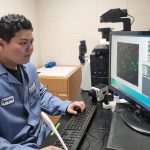Lighting the Way to Better Medical Treatments

Story from the Spring/Summer JHU Engineering Magazine.
Fireflies belong to the summer, floating above lush green lawns like a glowing galaxy come to Earth to illuminate warm evenings.
But in a laboratory on Johns Hopkins’ East Baltimore campus, the winged beetles—or at least, the enzyme that makes them glimmer and shine—are lighting the way to better treatment for everything from cancer to tissue damaged by amyotrophic lateral sclerosis, also known as Lou Gehrig’s disease.
“We use stem cells to treat and understand a number of ailments, and it’s important for us to be able to track and follow these cells once they are in the body. Luciferase, the enzyme that makes fireflies glow, lets us do that,” says Ana Rosu, a senior biomedical engineering major working in the lab of Jeff Bulte, an affiliate in the Johns Hopkins Institute for NanoBioTechology and faculty member at the Johns Hopkins University School of Medicine.
Fireflies (also called “lightning bugs”) use luciferase, another chemical called luciferin, oxygen, and ATP (energy-carrying molecules found in all cells) to kindle light in specialized organs located in their abdomens so they can communicate with each other and find mates.
Rosu and Bulte’s team leverages that chemical reaction by injecting stem cells that contain luciferase into animal models and following up with a chaser of luciferin, causing the original cells to illuminate. Then the researchers use sensitive optical imaging instruments to follow these cells, beaming like infinitesimal car headlights navigating a dark roadway, on their journey throughout the body.
“Because only live cells can oxidize luciferin and produce light, we can use the light imaging signal as a surrogate marker for cell survival to answer the two important questions: how long our injected cells survive, and when [targeted] tumor cells are starting to die,” Rosu explains.
This is crucial information in the team’s investigation into Lou Gehrig’s and other diseases that cause damage to the myelin: the protective sheath surrounding nerve fibers in the brain, eyes, and spinal cord.
“Sometimes, stem cells are rejected by the host, so we need to give immunosuppressants. But it is important to optimize treatment protocols so the stem cells that are there as therapy can survive as long as they can. So we use the luciferase chemical reaction on various days, allowing us to see how long the therapeutic stem cells survive,” Rosu says.
The team is also using stem cells to deliver gold and bismuth nanoparticles to tumors, which can kill the cancerous cells. Once the cells arrive, the researchers apply a laser to heat up the particles, “frying the tumor,” Rosu notes.
“So what we do is engineer the tumor cells with luciferase before we implant them, and then we inject luciferin daily afterwards to see how many cancer cells—if any—survive,” she says.





